By Keith Austin
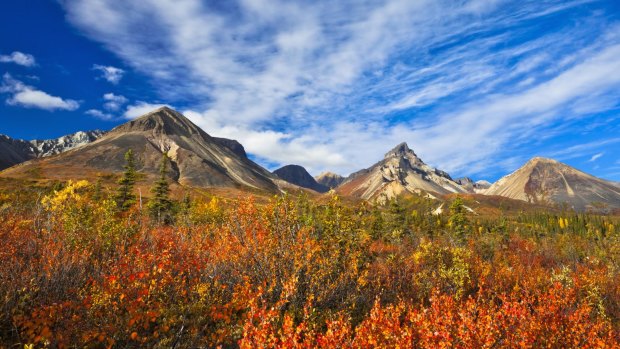
The Oregon countryside is rich with maple, pine, mountain ash and fir trees.Credit: Getty Images
Crater Lake in southern Oregon is spectacular, the sort of view that really does leave you speechless. Or saying something lame like "wow". It is essentially the hole that was left in the summit of a massive volcano that blew its top about 8000 years ago and which then, over 750 years, filled up with rainwater and melting snow.
The hole, or caldera, is an almost perfect circle (8km by 9.7km), with vertigo-inducing sides which drop steeply into eerily calm, beautifully clear blue waters. Where we are standing is 2165 metres above sea level. The surface of the lake is at 1882 metres and the drop is pretty much straight down into, at 594 metres, the deepest lake in the United States.
And it is on the lip of this (hopefully) extinct volcano that a group of 40 musicians will gather on the last weekend in July this year to perform the Crater Lake Symphony, a work specially commissioned to celebrate the 100th anniversary of America's National Park Service.
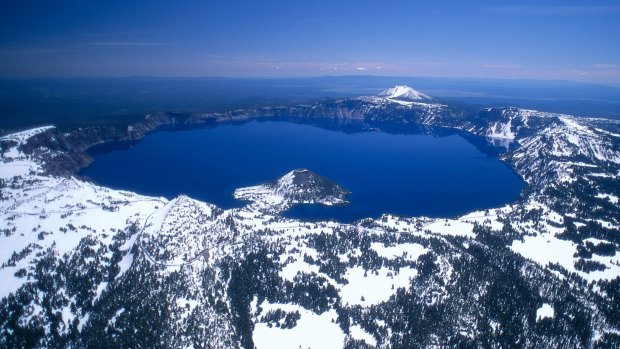
At 594 metres, Crater Lake is the deepest lake in the United States.Credit: Getty Images
It will be a spectacular backdrop for the world premiere of New York-based composer Michael Gordon's composition, commissioned by the local Britt music and Arts Festival and inspired by Crater Lake itself.
For it was 100 years ago, on August 25, 1916, that the then American president, Woodrow Wilson, scribbled his moniker on the bottom of the wonderfully named Organic Act. In doing so he created the National Park Service (NPS) and guaranteed that the country's national parks (all 35 of them at the time) would be protected and preserved by Federal government.
Among the 35 was Crater Lake National Park, established in 1902 by President Theodore Roosevelt. It is the fifth oldest national park in the country, the only national park in Oregon, and its popular centrepiece is the pristine clear-blue caldera of Crater Lake – which Roosevelt himself believed to be one of the wonders of the world.
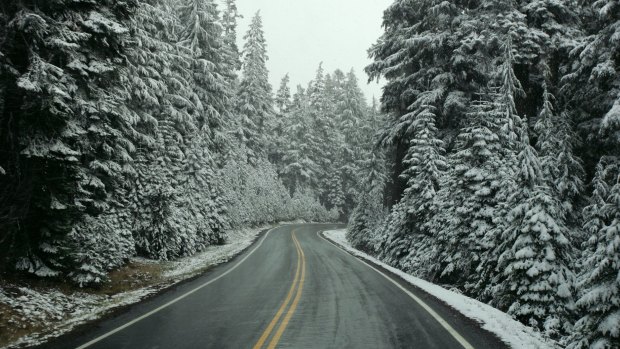
The trip to Crater Lake is a snowy drive.Credit: Oksana Perkins
The first non-Native American to see the lake was gold prospector John Wesley Hillman, in 1853. Obviously a literal-minded man, Hillman named it Deep Blue Lake. In the intervening years it has been renamed Blue Lake, Lake Majesty and, finally, Crater Lake. There are no plans that I know of to name it again.
The nearest town to Crater Lake is Klamath Falls, a small, slow burg (population about 21,000) in southern Oregon that owes its initial existence to logging and was, according to Discover Klamath sales and advertising manager Lisa Galloway, one of the fastest growing towns in the nation at one point. It's also handily situated on the breathtaking Coast Starlight Amtrak train which links Los Angeles to Seattle, taking in San Francisco and Portland on the way.
Before picking up my rental car, Galloway takes us on a whistle-stop tour of the town. It is, she explains, home to the largest wintering population of bald eagles in the USA, has footpaths heated by geothermal power, is on the Pacific Flyway migratory path with "hundreds of thousands of birds visiting every year" and is also the sunniest place in Oregon, with 300 days of sunshine annually.
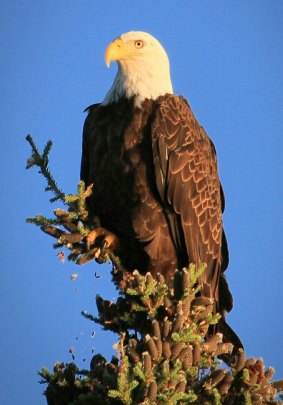
Bald eagles dot the Oregon sky and swoop on scrambling ducks.Credit: David Backes
The streets are wide and peaceful and dotted with solid old buildings that attest to its former status as THE place to come to make your fortune in this wild frontier. It's on the edge of a large lake and surrounded by hills rich with maple, pine, mountain ash and fir trees. Bald eagles dot the skies overhead or swoop down in front of your rental car chasing frantic ducks (true story).
Quite apart from Klamath Falls itself, which is almost cliched in its pretty, small-town America vibe, the surrounding countryside is spectacular. This is kayaking, whitewater rafting, hunting, shooting and fishing country. Come back in October, says Galloway, and there's nothing doing in town because everyone's off hunting. Imagine Twin Peaks but without the weirdness (if you can discount the 44 sightings of sasquatch in the area).
After taking leave of Galloway on the outskirts of town I point my Tahoe SUV in the direction of Crater Lake. On the radio, country singer Luke Bryan has finished warbling Huntin', Fishin', Lovin' Every Day and Toby Keith has started up with "I'll find what I want in a honky tonk, I like girls that drink beer" when I spot my first bit of snow.
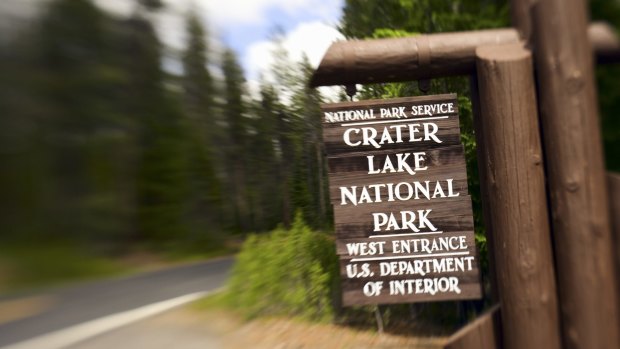
Crater Lake National Park was established in 1902 by President Theodore Roosevelt. It is the fifth oldest national park in the country. Credit: Thinkstock
Now, if you were driving in southern Oregon earlier this year and spotted some idiot taking photographs of patches of snow, yes, that was me. At this point I had no idea that, on the ascent to Crater Lake, the patches of snow would gradually join up, pile up and eventually tower on both sides of the road in great frozen walls about five metres high and that to explore the sides of the crater I would have to snap on snow shoes.
Still, it was a bright sunny day with cloudless blue skies – one of the 300 mentioned earlier – and certainly the best way to see the lake itself. At the top of the serpentine road is Rim Village, which consists of a cafe and gift shop and, further along, the Crater Lake Lodge which, at the time of my visit, was unopened and still snowed in, like some sort of benign Overlook Hotel from The Shining movie.
At the cafe I meet assistant general manager Andy Stiles, who has worked at Rim Village for a year, and we take a walk out to the edge of the lake, which is reached by clambering up a steep and slippery embankment of snow. The ends of pine trees stick out of the top of it and, as we crest the summit, the lake comes suddenly into full view.
From where we stand there is a decent view of Wizard Island, named for its supposed resemblance to a wizard's hat, but Stiles tells me the best, uninterrupted view is a little way off to our left – a short walk best done at this time in snow shoes.
These, sadly, turn out not to be the twangy, dodgy tennis racquets of popular imagination but are still lovingly low-tech and surprisingly easy to use. While it's not the whole 50-kilometre loop around the lake, which takes experienced trekkers three days and requires a backcountry permit, my short hike towards Discovery Point and Wizard Island Lookout is exhilarating.
There's something refreshing about trudging across fresh, completely unmarked snow under a cloudless sapphire sky, the sting of icy air on your cheeks, each turn bringing with it panoramic views across a brilliantly deep blue lake created by a volcanic explosion 8000 years ago.
Snowshoe rental is $US16 a day ($US12.50 for children) but free on weekend guided tours with park rangers from late November through to the end of April. The walks take two hours and cover 1.6-3.2 kilometres.
That night I stay at Prospect, a small town just 45 kilometres away off Route 62 and perched alongside the Rogue River, which tumbles down out of the mountains. It is a town with the usual logging history of hereabouts – the first sawmill opened in 1870 – and was originally named Deskins, after the first postmaster.
The Prospect Historic Inn, where I am staying, opened in 1892 and was listed on the National Register of Historic Places in 1980. Even in 1909 the hotel's guest books show travellers arriving from as far away as Italy, France, Germany, Hungary and Russia to see Crater Lake.
Run today with disarming charm by the affable Fred and Karen Wickman, the hotel is a magnificent former stage coach stop, a two-storey building with four large gables and a wrap-around verandah. Inside it is full of nooks and crannies crammed with comfortable furniture and a restaurant serving good, wholesome food.
The next morning arrives with a surprise; the clear blue skies of yesterday have been replaced by a snowstorm. Of course, I say "snowstorm" but Oregonians would probably call it a flurry. Yeah, tell that to the 12 centimetres of snow on top of my rental car.
I decide to walk to a nearby waterfall dotted with boulders said to have been thrown there from the explosion that created Crater Lake. It is like strolling through a winter wonderland, the forest floor already carpeted with snow which is also piling up on the tree branches. The river is a rough tumble of rushing water and the boulders, slick and black, have a thin white snow topping, like icing on massive dark chocolate truffles.
It is icy out here now and all colour seems to have been sucked out of the place, the cloud cover, the snow and the trees turning everything black and white. Suddenly it's Lion, Witch and Wardrobe country and, heading back to the hotel with camera tucked under raincoat, I feel like Mr Tumnus clutching his parcels and hurrying home out of the cold.
It's a far cry from yesterday's blue skies but then I remember what someone had said the day before: "Around here we say 'Don't like the weather? Wait'."
TRIP NOTES
MORE INFORMATION
traveloregon.com; DiscoverKlamath.com
GETTING THERE
Amtrak trains run daily from Los Angeles' Union Station to Seattle, leaving at 10.10am and arriving at Klamath Falls at 8am the following morning. Prices for superliner roomettes sleeping two people start from about $580; see amtrak.com
STAYING THERE
The Prospect Historic Hotel in Prospect has rooms in the main house from $US140-$US295 a night, depending on the season. Price includes breakfast. Motel room rates range from $US80-$US220 a night, depending on the season; see prospecthotel.com
CRATER LAKE SYMPHONY
On July 29 and 30 some 40 members of the Britt Orchestra, 15 members of Steiger Butte Drum, 30 brass and percussion students from Southern Oregon University and a 50-strong regional choir will perform the new Crater Lake Symphony. The world premiere performance takes place at 10am on Friday, July 29 at Watchman Overlook Corral. This performance is by invitation only, but anyone walking or biking in is welcome to attend and all performances are free; see brittfest.org.
A CENTURY OF THE NATIONAL PARKS SERVICE
When President Woodrow Wilson signed the Organic Act in 1916, little could he have known that the desire to preserve nature and wildlife for future generations would eventually become the vast 34 million hectare network of 411 parks, forests, monuments, battlefields and coastline that it is today.
Just four years after he signed the act, 1 million people were visiting the national parks annually. In 2015, more than 307 million people visited US parks and spent some $US27 billion in and around them. The National Park Service has a budget of about $US3.65 billion and employs 22,000 people but their work is augmented by 221,000 volunteers.
The largest national park is the Wrangell-St. Elias Park and Preserve in Alaska (5.3 million hectares), while the smallest, at just 800 square metres, is the Thaddeus Kosciuszko National Memorial in Philadelphia, Pennsylvania. And yes, that's the very same bloke after whom Mount Kosciuszko is named.
NATURE'S BEST: FIVE MORE GREAT NATIONAL PARKS OF AMERICA
YOSEMITE
Known for its giant sequoia tree groves and iconic cliff formations, Yosemite, in California's Sierra Nevada mountains, is one of the most well-known of the national parks. Almost 4 million people a year visit its 3000 square kilometres. Black bears, coyotes, bobcats, cougars and deer live there.
GRAND CANYON
A mile deep in some places, Arizona's Grand Canyon is one of those places for which no amount of photographs can prepare you. Its 5000 square kilometres are simply astonishing. Hiking and rafting on the Colorado River are popular activities.
YELLOWSTONE
The first national park in the world, Yellowstone is the home of Old Faithful, one of 300 geysers in the park. Hot springs of amazing hues are another attraction. The wide Lamar Valley is the place to see bears, wolves and bison.
JOSHUA TREE
At the meeting of two deserts – the Colorado and the Mojave – this harsh and forbidding landscape features the famous shapes of the Joshua trees – named by Mormons who thought they looked like hands raised in prayer.
BRYCE CANYON
The spectacular pillars of rock in Utah – the result of rock erosion and known as hoodoos - have been described as a cave without a roof. Go at sunrise or sunset for the best light.
See nps.gov; visittheusa.com.au
Keith Austin was a guest of Travel Oregon and Discover Klamath.
Sign up for the Traveller Deals newsletter
Get exclusive travel deals delivered straight to your inbox. Sign up now.